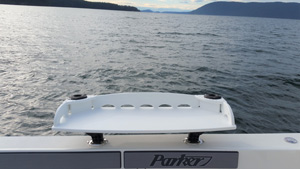Don’t winterize that boat just yet. Or at all, for that matter. Even though November isn’t the busiest time for saltwater fishing, there are opportunities to put a catch on the table. Plus, good blackmouth fishing is right around the corner.
We’ll go through the basics of blackmouth this month to get you geared up to go out and get them. While many savvy anglers enjoy success jigging darts or mooching herring for blackmouth, or resident Chinook as they’re also called, downrigger trolling is the most popular method. What bait to cast is not a complicated question, as these fish are on the feed. That’s why they’re called feeder chinook as well. My go-to has always been small spoons behind an 11” flasher.
However, hootchies, Silver Horde Ace-Hi flies, plugs, and, of course, herring or anchovies will all catch fish. Smaller flashers and dodgers work in front of your offering too. Don’t be afraid to switch things up and try something new. It’s fun to come up with something different. A plastic lure, like a Berkley Gulp! Sand Eel, is an experiment that worked for me. They look like a candlefish or sand lance, some of the blackmouth’s favorite food.

Speaking of food, finding the baitfish that these salmon are after is paramount to success. Use your electronics to find schools of bait. Candlefish will look like a cloud on the bottom. Herring will be in balls, more suspended. The majority of resident Chinook will be caught close to the bottom.
Make sure your downrigger balls are not more than 15 feet off the bottom for the highest percentage of success. Target slack tide at either a high or low to find the bait and catch these fish. There are many exceptions, but overall, most blackmouth are caught at the tide change.
Although this fishery is not the most complex, there is a lot to learn. Read and study as much as you can, but really, there’s no substitute for time on the water and giving it the old college try. Maybe just don’t think this season’s Washington State football type of try.
Fall crabbing opens yet another option to get some groceries. It’s a great activity in the San Juan Islands and beyond this time of year. Watch the weather and maybe a larger boat won’t be needed. Methods are the same as summer crabbing, and if you saved heads and carcasses from summer salmon catches, they work very well. Make sure and check the regulations before you go. Many areas in Washington open for this late season, but some remain closed.
Fishing for squid can be a productive fall pastime. Or is it “squidding” for squid? Regardless, they turn into tasty calamari. It seems that squid migrate from the ocean and straits into Puget Sound proper around this time of year. Not much is known about why this migration takes place. For some reason, they find the conditions in the Sound more favorable in the fall. Good for the squid fisher!
Squid mostly feed at night but can be caught during the day. They are attracted to lighted areas, such as docks or piers. However, from a boat you can create your own light by hanging some light bars and the like off the side above the water.
A longer, lighted rod with a lighter line works best for these critters. You want to be able to feel changes in action when a squid latches on to your lure.
The squid jigs are usually luminous with multiple hooks. Checking with your local tackle store to see what’s working is usually the best way to choose gear for the uninitiated.
Squidding seems to be more productive on a high, slack tide in cloudy conditions. This will make the artificial light more noticeable. When jigging, cast out some distance from the boat and allow the lure to sink. Then retrieve it back to the boat with a steady, jerking motion. If you’re not getting hit, try letting the lure sink deeper. Still not getting hit, try shallower.
Squid congregate in schools. When you do get a squid on, you’ll feel a change in the behavior of your lure and then jerk upward to set the hooks. Keep the steady pressure on while reeling in. The squid may not actually be hooked, but possibly just entwined in the lure with their tentacles. Don’t be surprised when you bring in your catch if the squid deploys its defense mechanism of shooting ink. The substance is water soluble and will wash off if dealt with quickly.
There was a lot to be thankful for in the Northwest fishing scene this year and we’ve still got a couple months to cap it off. Until next month, let’s get out and make some memories!
